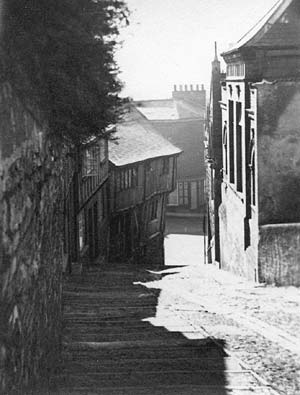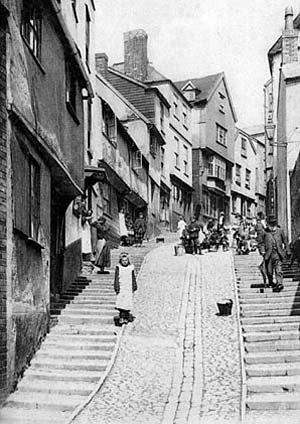
Stepcote Hill
Page updated 18th September 2013
 This street is one of
the oldest surviving parts of Exeter, located in
the West Quarter. According to Hoskins, its name comes from the Old English word for steep,
rather than from step, and cote for enclosure. In 1270 it was referred to as Styppecotehyll, and had become Stepcote Hill by 1588, according to a deed.
This street is one of
the oldest surviving parts of Exeter, located in
the West Quarter. According to Hoskins, its name comes from the Old English word for steep,
rather than from step, and cote for enclosure. In 1270 it was referred to as Styppecotehyll, and had become Stepcote Hill by 1588, according to a deed.
The hill had been used as the main route into Exeter from the river
since Roman times, and it was used by strings of pack horses and weary
travellers, before New Bridge Street was
constructed. The entrance to the street is flanked by St Mary Steps Church on the left, and a pair of timber framed houses that date from about 1500, on the right. Going up the street, the first turn on the right, behind the two fore mentioned houses, and opposite the church chancel door, is Parsonage Lane, so called because it once led to 'the rector's and school-master's houses'. (1)
One early reference to the street from 20th September, 1462, gives an account of the will of Felicia Selman, in which she gave the parish two cottages with adjoining gardens, on Stepcote Hill, which was to be administered by the feoffees. In addition, on the anniversary of her will, 4d was to be paid to the rector, 3d to each of the two priests, 3d to two clerks, 2s to be spent on bread and beer, 2d on cheese, 2d given to the church-wardens and the remainder was to go to the church. (1)
A new King in the street
When William of Orange was invited to take the
throne with his wife Mary from James II in 1688, he landed at Brixham
and marched to Exeter, enroute for London.
He rode up Stepcote Hill with a large force of "200 Blacks from the Plantations of the
Netherlands in America...200 Finlanders...all in bright
armour". (4)
In the early 18th Century the street and area was inhabited by
merchants. A record shows that a certain Thomas Clutterbuck had
imported lemons and fresh lime juice at 5 shillings
per gallon, expensive and rare commodities in Exeter at that time, for
sale from his premises in Stepcote Street. At roughly the same time,
Stepcote Hill was said to be not only
congested, but to contain some expensive property; one house, garden
and packing chamber, owned by the fuller Nicholas Dark, was insured in
1740 for £1,000, the same value
for which the New Inn in the High Street had been insured, only eleven
years earlier. (4)
A few years later, Andrew Brice wrote of Stepcote Hill "A descent called Stepcote-Hill, to which
the Butcherow leads.... the Guts, Blood, Litter,
Ordure and a variety of Nastiness are, in hard showers of rain, rapidly
carried.... into the River". In 1802, Mrs Flashman was
fined "1s for throwing filth before
her door in Stepcote-hill" which will not have helped the
situation. (2)
Victorian times
Although a new route into the city from the west was opened, when the the old medieval bridge was replaced in 1778, Stepcote Hill still carried some traffic. James Cossins reminisced in 1877 of Stepcote Hill from around 1820 "The direct line from the Old Bridge was up Stepcote hill. I have seen three horses pulling a waggon up that steep ascent." (3)
The street still supported some commercial enterprise, and in November 1820, John Hancock and Son, thanked their many customers for supporting their business as manufacturers of Tortoise-shell, Ivory and Horn combs. By 1834, Hancock's house was for sale as the last of the old merchant class moved out. There were a number of sales of property, as the nature of the area changed. In 1835, Turner's Buildings, "ten compact and well built Dwelling-Houses, calculated for the occupation of mechanics, and now fully and respectively Tenanted, producing together an Annual Rental of £76 4s.... Each house will be entitled to an exclusive Garden frontage, to the use of a Pump of Excellent Well Water in common, and to other conveniences" were offered for sale. (7)
Later in the 19th Century, the area was home to a large, poverty stricken artisan and labouring class. The area was afflicted with bouts of cholera and the inhabitants suffered from poor health and short lives. There were 15 deaths from the cholera in 1832, and even though Preston Street had 43 and Smythen Street 24 victims, the number in Stepcote Hill was high, relative to its length. The next year, and the Exeter Commissioners of Improvement were concerned that so few on the hill had connected their house to the public sewers. Parsonage Court was declared unfit for human habitation in May 1878 by the jury in an inquest, after they visited the court during their duties. The Council installed a public fountain at the bottom of the street which also had a trough for horses and dogs, but it did little for the living conditions of the hill.
In 1892, a new Parish Hall and Sunday School was built by St Mary Steps Church on a plot immediately behind the church, that had formerly been tenements. It still exists, and is used as The Hall, a community arts space.
Many worked in the nearby cattle market and slaughterhouse, in Bonhay Road, a tannery, a soap and candle manufacturer and various flour mills and the stench was very unpleasant. Frank Shooter, the Hero of the Exe, and a man who depended on his health and fitness was listed living in Stepcote Hill for a number of years. The only public house on the hill during this time was the City Arms, which had a reputation "as it had given rise to some notoriety in the Court."
Mrs Whitehead was interviewed in the 1977 and said "I was born at Stepcote Hill in 1897, so you can tell I'm 80. I remember some things of Stepcote Hill. I used to run up and down the steps, down through the centre. There was an old lady who used to sell winkles; she'd sit on a chair and pick 'em out. I can picture that, young as I was." (5) The photo on the right could almost be of the old lady when she was a child.
The area had the the worst living conditions in the south-west of
England, and yet, even at the turn of the 20th-Century, artists and
writers would allude to the antiquarian interest and visual
attractiveness of the little street, neatly avoiding the poverty and
filth. Still, before the great clearance, the inhabitants had a fish
and chip shop open on the corner of King Street. (4) In 1928 a policy of
clearing the slums and moving the
population out to Burnthouse Lane, known
locally
as 'Siberia' was started. The
fish and chip shop was a victim of the clearance when it was replaced
by the King's Dwellings in 1933, built by the Exeter Workmen's
Dwellings Company Ltd, which still exists as Cornerstone (formerly Southernhay), who now have an office in Combe Street.
This list is from a street directory published in 1897 (6) - it gives a
picture of the trades that people followed to make a living at that
time.
Stepcote
hill, King street to West street.
1 Snell Henry, general dealr
2 Browning Mrs. Sarah, dairy
3 Bennett Richard, baker
7 Jones Mrs. Maria, chair mender
8 Hill William, shopkeeper
St. MarySteps Sunday Schl Harvey Arthur, boot ma(ker)
23 City Arms P.H. Mrs. Emily Jennings
24 Parsons John, coal dealer
26 Lindsey Henry, shopkeepr
27 Hill Mrs. Maria, wardrobe dealer
Source: Transactions of the Exeter Diocesan Architectural Society, Volume 4 (1) Brice's Mobiad (2), James Cossins (3), Eighteenth Century Exeter by Robert Newton (4), People Talking by Jenny Lloyd (5), and Kelly's Directory (6), the Flying Post (7).
 Looking
down Stepcote Hill circa 1950 Photo by Maurice Swansborough.
Looking
down Stepcote Hill circa 1950 Photo by Maurice Swansborough. Children on Stepcote Hill circa 1900.
Children on Stepcote Hill circa 1900.
Courts off Stepcote Hill
Eveleigh
Court
George's Square
Morgan's Court
Parsonage/Parson's Court
Turner's
Buildings
Williams' Court
│ Top of Page │